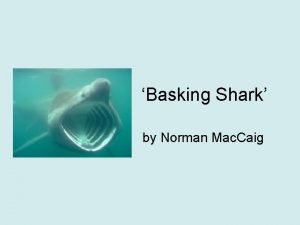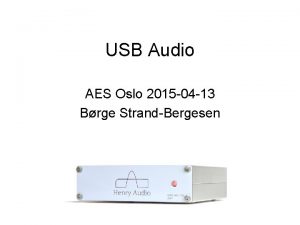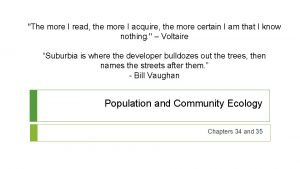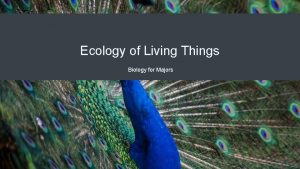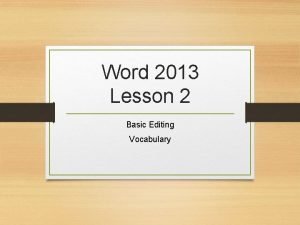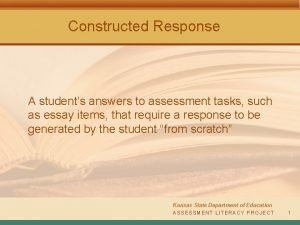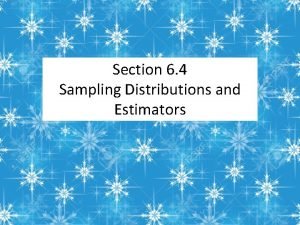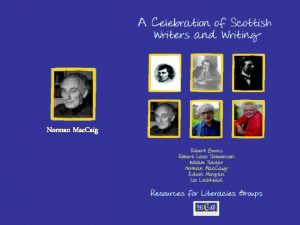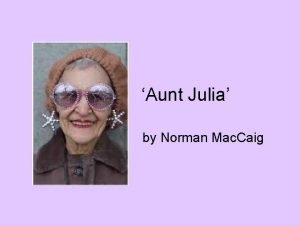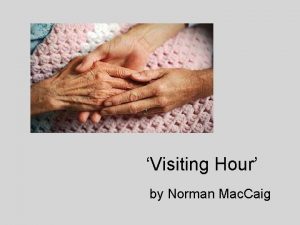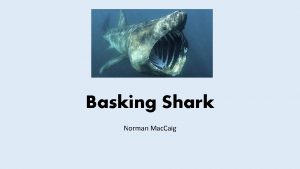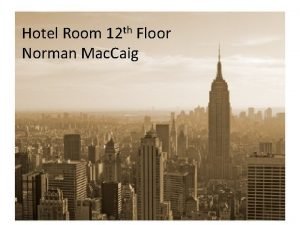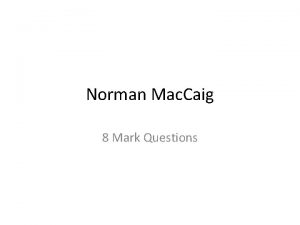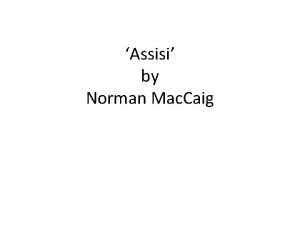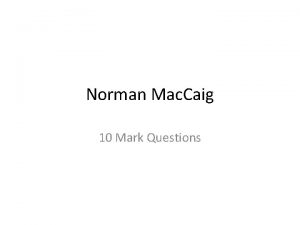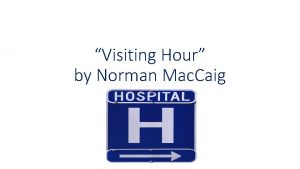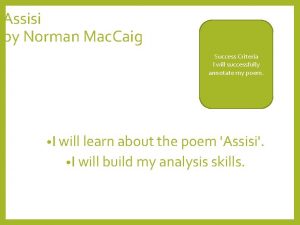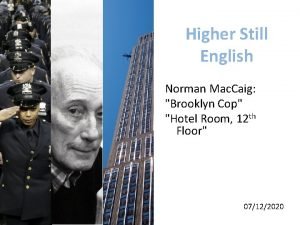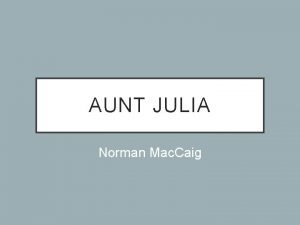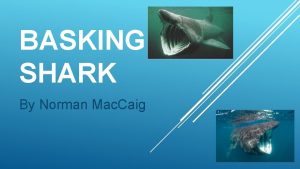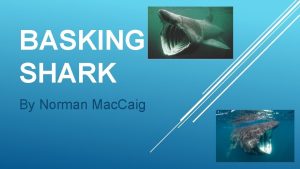Selected Poetry of Norman Mac Caig National 5



















- Slides: 19

Selected Poetry of Norman Mac. Caig National 5 - Specified Texts

“Visiting Hour” by Norman Mac. Caig

What’s Happening? • The poet is visiting a dying friend or relative in hospital, and tries to avoid his emotions on his way to the ward. • When he arrives, he is overcome by grief and anguish, and leaves the visit feeling it has been pointless.

Key Themes • Facing Death (either the dying person, or the relative) • Isolation surrounding death/emotion

The overall structure of the poem contributes to the atmosphere and mood • Verse 1 -3 are short, staccato and create a sense of place, atmosphere and the poet’s feelings • Verse 4 – sense of busy hospital • Verse 5 – main action, sense of hush in the presence of dying woman. • Verse 6 – opening of floodgates of poet’s emotions in face of his inevitable loss.

Useful Terms • Synecdoche - A figure of speech in which a part is used to represent the whole (for example, ABCs for alphabet) or the whole for a part (“Spain won the World Cup"). • Synaesthesia - an attempt to fuse different senses by describing one in terms of another (Example: the sound of her voice was sweet) • Free verse - lines with no prescribed pattern or structure • Enjambment - the continuation of a sentence over a linebreak. Enjambment is one way of emphasising a particular word or phrase

Useful Terms • Connotation - the implied or suggested meaning connected with a word • Caesura - a strong pause within a line. It is often found alongside enjambment. If all the pauses in the sense of the poem were to occur at the line breaks, this could become dull; moving the pauses so they occur within the line creates interest. • Guttural - Produced in the throat; harsh-sounding • Plosive - consonant produced by stopping the flow of air at some point and suddenly releasing it (as `p'' and `d'' in `pit'' or `dog'') • Oxymoron - joining contradictory terms (as in `deafening silence'‘)

Imagery • “… nostrils/ as they go bobbing along” – Synecdoche is used, since not just his nostrils are moving along, as the image would suggest. This emphasises the overpowering nature of “the hospital smell”, since it has blocked out his other senses. • “white cave of forgetfulness” – Metaphor, suggesting the white curtains or sheets are cave-like (impenetrable). This conveys the isolation of the woman, and the poet’s exclusion from her. • “withered hand/ trembles on its stalk” – Metaphor, suggesting the woman’s body is brittle and frail, by comparing it to a dying flower. The image suggests the woman’s body has deteriorated, but contains hope for regrowth (afterlife), as well as showing the love with which the poet looks on the woman.

Imagery • “glass fang” – Metaphor, suggesting the intravenous drip is vampire-like. The horror in this image is shocking, which shows the poet’s grief and distress at seeing the woman’s condition, and being unable to help her. • “black figure in her white cave” – Metaphor, referring to the universal image of Death, “figure” also suggesting the woman’s blurred vision. This emphasises the isolation of the woman, as well as her impending and unavoidable death. • “the round swimming waves of a bell” – Synaesthesia, as a visual image describes a sound (signalling the end of the Visiting Hour? ). “swimming” could suggest the poet’s dizziness (confusion) or tears. This is from the woman’s point of view, so further shows her isolation, and the poet’s isolation from her.

Structure • Free verse is used throughout, which reflects the poet’s confusion and suits the narrative style of the text (there is an introduction to the character and setting, followed by development, climax, and an epilogue) • The verses deal with the poet’s progression through the visit, from his entering the hospital and making his way to the ward, up to him leaving after the visit. Also, each verse reveals more of the poet’s emotions. • The first line of the poem is effective in grabbing the reader’s attention, by referring to a very vivid and distinctive sensory image; “The hospital smell” which the reader can associate with.

Structure • “What seems a corpse/ is trundled into a lift and vanishes/ heavenward” – Enjambment is used here to emphasise the last words of the lines, carefully chosen to suggest a finality in death; “corpse” containing very little connotation of life, and “vanishes” further stressing the poet’s view that death is absolute. • “heavenward” therefore seems incongruous, although this is simply an example of Mac. Caig trying to avoid the seriousness of the visit by creating whimsical images. • “I will not feel, I will not/ feel, until/ I have to. ” – Repetition is used to suggest the poet is chanting under his breath in order to avoid his emotions.

Structure • “here and up and down and there” there – the unusual word order is another example of the poet trying to lighten the mood, while also emphasising the number of nurses he sees. It suggests Mac. Caig is looking all around to find a distraction from his thoughts. • “so much pain, so/ many deaths …/ so many farewells” - Repetition of “so” stresses the frequency of the nurses’ unpleasant dealings, which supports the high esteem, perhaps envy, with which he regards the ability of the nurses to cope. • “Ward 7. ” – The abruptness of this non-sentence jolts the reader, just as we can imagine it affected Mac. Caig; this effect is heightened by the caesura it causes. This is the turning point of the poem, as he has now reached his relative and must face his emotions.

Structure • “A withered hand/ trembles on its stalk” – Use of the pronoun diminishes the humanity of the woman, suggesting the poet does not feel the relative is truly alive; her body is merely an empty shell, while she is effectively dead. There are further examples in the rest of the verse, which serve to emphasise his point. • “books that will not be read/ and fruitless fruits” – Enjambment causes the last line to seem like a bitter addition, which summarises the poet’s despair at the hopelessness of his situation, and the isolation both he and his relative have suffered.

Word Choice • “combs my nostrils” – gives a sense of the pervasive power of the smell, and his feeling of being invaded; showing his discomfort. • “green and yellow corridors” – colours have connotations of sickness, which further stresses the poet’s discomfort in these surroundings. • “corpse” – holds little relation to life, suggesting the finality of death. The harshness of the sound; with a guttural “c” and plosive “p”, shows the poet’s distress and the painful emotions he is facing. • “heavenward” – incongruous with the poet’s beliefs, expressed in the previous lines; simply an example of Mac. Caig using humour to avoid his emotions. • “miraculously” – suggests Mac. Caig’s admiration for the nurses’ abilities, while showing his own worry about the way he will cope with the emotions.

Word Choice • “farewells” – the ending of the verse on this draws attention to the word, which underlines the purpose of his visit. Defined as “good wishes on parting”, the word is suggestive of the possibility the people will meet again, and that those departing are going on some kind of journey – this perhaps shows the poet’s desire to believe in an afterlife, especially at such troubling times. • “white cave” – holds connotations of isolation through confusion or sensory blankness (e. g. “white noise”) • “not guzzling but giving” – the horror of the “glass fang” image is continued in the word “guzzling”, but is reversed by the positive word, “giving”. The use of the guttural “g” sound in the alliteration conveys the harshness of the poet’s interpretation; he clearly sees the process as intrusive and pointless.

Word Choice • “clumsily … dizzily” – shows the poet is overcome by his emotions, leaving him confused and dazed. • “fainter” – showing the woman’s vision is blurred; she can see him getting fainter with distance. Also a pun, since the poet may be so upset he is starting to feel faint. • “fruitless fruits” – the final words are an oxymoron: how can a fruit be fruitless? This captures the poet’s despair at the pointlessness of the woman’s death being prolonged, and his inability to help – bringing fruit has been “fruitless”, i. e. pointless.

Class Discussion Think about… • Is it less of an ordeal for the dying person than the one left behind? • Dying is something we have to do alone, despite being surrounded by loved ones? • How realistic do you find the poet’s feelings?

Practice Critical Reading Individual Task • On the next slide are some textual analysis questions all about “Visiting Hour” by Norman Mac. Caig. • You should answer these questions, referring to the text in your answers. • Remember you should attempt ALL the questions

“The hospital smell combs my nostrils as they go bobbing along” (lines 1 – 3) 1. Comment on the poet’s use of imagery in these opening lines. Why is it effective? (2) 2. “What seems like a corpse is trundled into a lift and vanishes heavenward” heavenward (lines 5 -7) Comment on the poet’s use of word choice in these lines. What do these words tell you about the poet’s mood at this point? (3) 3. In verse 5, the poet finally reaches he ward where his relative lies. What is the effect of the sentence “Ward 7. ”? (2) 4. Re-read verse 5. Identify ONE image used by Mac. Caig and comment on its effectiveness. (2)
 Decadent townee
Decadent townee Real macbeth
Real macbeth Mac mac o kok dac
Mac mac o kok dac Qualitative and quantitative data analysis
Qualitative and quantitative data analysis Survivorship curve for k selected species
Survivorship curve for k selected species What is a selected response question?
What is a selected response question? To understand and interpret social interactions
To understand and interpret social interactions Vba combobox selected item
Vba combobox selected item K selected species survivorship curve
K selected species survivorship curve Example of r selected species
Example of r selected species Weights of the backpacks of first graders on a school bus
Weights of the backpacks of first graders on a school bus Word basic
Word basic Understanding population pyramids
Understanding population pyramids Not only the students but also their instructor
Not only the students but also their instructor Delete it
Delete it Selected response tasks
Selected response tasks In bsr mode
In bsr mode Congratulations you have been selected
Congratulations you have been selected Three randomly selected households are surveyed 2 6 7
Three randomly selected households are surveyed 2 6 7 K selected
K selected
